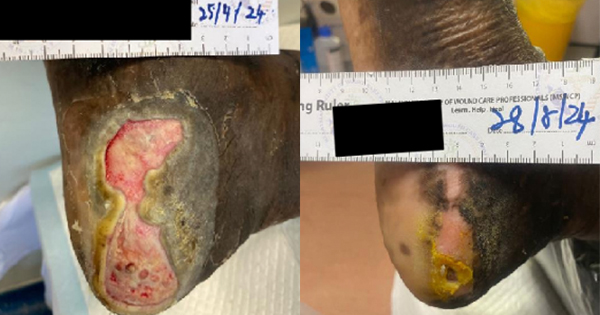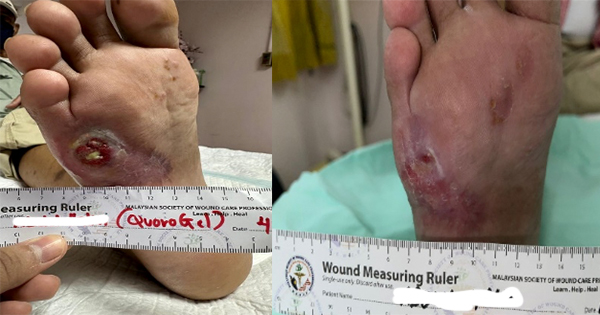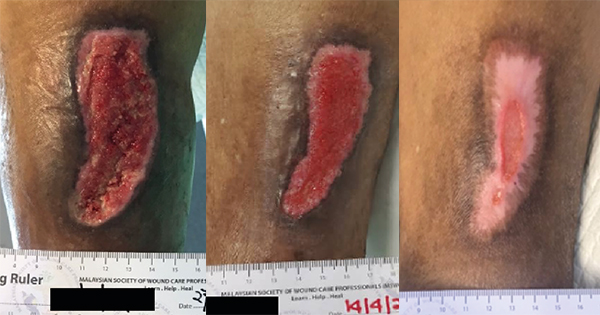Chronic wounds, such as diabetic foot ulcers, venous ulcers and pressure injuries, present considerable clinical challenges due to their extended healing times and elevated risk of infection. These wounds are often linked to underlying conditions like diabetes, hypertension and vascular insufficiency, which disrupt the body’s natural healing mechanisms. Effective management of chronic wounds requires a thorough, multidisciplinary strategy, encompassing not only surgical procedures, such as debridement and amputations, but also the application of advanced wound dressings and ongoing monitoring to avert complications.
Addressing these hard-to-heal wounds poses a significant hurdle for both patients and healthcare providers, primarily because of the prolonged treatment needed. Such wounds typically occur when the normal healing process is interrupted, resulting in delayed recovery (Han et al, 2017). Factors that impede wound healing include the patient’s overall health, wound characteristics (such as size, duration and location), the quality of clinical care and various physiological conditions (Dowsett et al, 2015).
A key goal in managing chronic wounds is to prevent infection and remove non-viable tissue. The loss of the skin’s protective barrier makes these wounds highly susceptible to infections, and the presence of pathogens can further delay healing (Han et al, 2017). Additionally, debridement — which involves the removal of necrotic tissue — is crucial, as it exposes healthy tissue and facilitates the migration and proliferation of cells essential for wound repair.
Dermatix Wound Care contains a hydrogel that balances moisture levels, creating optimal environments for rapid and complete wound recovery. It is a paraben-free hydrocolloid gel indicated for local dry or moist wounds. It indirectly promotes wound healing by regulating the microenvironment of the wound. It is composed of acidic carbomer stabilised by carnosine; a basic peptide naturally present in the skin. Covering dry wounds, such as grazes and surgical wounds, with this carbomer has occlusive effects, where it prevents evaporation of moisture and reduces fluid loss through the epidermis. Carnosine buffers the acidic polymer and acts as an antioxidant. The carbomer absorbs excess fluid from moist, exudating wounds. It also cools and softens contact with plasters and/or bandages, and it is non-adhesive (Tan et al, 2019)
Dermatix Gel has been shown to enhance wound healing by maintaining a moist wound environment, which is critical for optimal recovery. Studies indicate that gels can improve the overall healing process, reduce pain, and decrease the risk of complications (Kramer et al, 2014; Yao et al, 2018). The gel’s non-stick formulation reduces pain during application and removal, which is particularly beneficial for sensitive or fragile skin (Berg et al, 2019).
One option to consider is hydrogel that contains glycerin, allowing it to shape to the surface of the wound and promote healing. This glycerin-rich type of hydrogel dressing is also much more fibrous and can be used for deeper wounds and chronic wounds that have created cavities or depressions in the skin. When applied, they do not adhere to wound surfaces and allow metabolites to pass freely (Peppas et al, 2006). These dressings help provide a cooling effect on the wound, which makes them pleasant and comfortable for patients.
Methodology
The case series took place in the Wound Care Clinic Hospital in Kuala Lumpur, Malaysia, between April 2024 and September 2024. It involved patients with chronic wounds. A convenience sampling method was used for this case series.
Inclusion criteria included patients with wounds that were present for more than one month. All the patients included have diabetes as a comorbidity. All patients underwent the same procedure in the clinic and were treated by nurses. All wounds were rinsed with sterile water. The wound was debrided as required. Dermatix gel was applied as a primary dressing and a nonabsorbent dressing was applied as secondary dressing. The wound was then secured with gauze and bandage. The dressings were changed three times a week until the end of the study. Offloading with padding was designated for DFUs, while two-layer compression treatment was given for patients with VLUs. No other advanced dressings that could alter the healing times were employed for this study.
The cases were followed from initial review to discharge, assessing treatment efficacy using wound size. The wound was continuously assessed via Tissue, Infection, Moisture and Edge of Wound (TIME) assessment (Nair et al, 2021) and the periwound skin assessed using Harikrishna Periwound Skin Classification (HPSC; Nair et al, 2020). The wound bed was described and any changes from baseline wound appearance were documented on every visit to allow determination of changes in healing rate and wound size. Comprehensive monitoring, tracing the process from inception to discharge, predominantly relied on wound size as the key efficacy metric. Measurement of wounds (length x width) and their progress was assessed every time the dressing was changed.
This case series was carried out in accordance with the Declaration of Helsinki’s guidelines and approved by the hospital’s review board. Patients gave consent to use clinical images and case details for publication/research purposes before the start of the study.
Results
We recruited 10 patients (6) males and (4) females [Table 1]. Patients had various comorbidities, including diabetes mellitus (n=10), hypertension (n=7), and hyperlipidemia (n=4). Six patients were diagnosed with diabetic foot ulcers (DFU), while the remaining four had different conditions: one with a stage (3) pressure injury, one with a venous leg ulcer (VLU), one with a carbuncle, and one with a laparotomy wound [Table 1].
Figure 1 presents 10 typical chronic wound cases seen in the Wound Care Clinic at Hospital Kuala Lumpur. By the end of the study, five patients showed a clinically significant reduction in wound size, while five achieved a substantial reduction in wound size after treatment. Although wound size was maintained in five patients, the exudate had dried up or reduced to a minimal level in all ten patients.
Discussion
Dermatix Wound Care contains intelligent hydrogel that balances moisture levels, creating an optimal environment for rapid and complete wound recovery. It forms a protective layer over the wound and prevents contamination, which can help to avoid infection. Research findings also suggest that medicinal hydrogels can significantly relieve the pain, burning, and irritation commonly associated with skin wounds. All the patients had diabetes; however, they had a range of wounds.
In the case series detailed in this article, we have shown that Dermatix Wound Gel aids in wound healing, in different types of wounds. The average number of days taken for wound healing is 80.5 days. Five patients had a reduction of more than 80% in wound size. The HBA1c in nine patients showed uncontrolled diabetes, yet all patients had significant changes in wound size. Diabetic foot ulcers are particularly linked to compromised immunity and peripheral polyneuropathy, as well as microangiopathy. Additionally, the formation of reactive oxygen species due to protein glycosylation plays a significant role in damaging skin integrity. Studies revealed that the treatment duration was significantly longer in patients with HbA1C levels above 7%, which is the recommended threshold for managing other diabetes-related complications.
Hydrogels, typically made from polymers and capable of swelling in water, have been suggested as effective treatments because they maintain a moist environment conducive to wound healing. Their distinctive properties allow them to absorb wound exudate, conform to different shapes, and be tailored to include active substances like growth factors and antibacterial agents.
Hydrogels are made from intricate hydrophilic polymers and contain up to 90% water. These water-insoluble polymers expand when in contact with water and are semi-occlusive. They are employed to hydrate wounds, rehydrate eschar and assist in autolytic debridement (Weller et al, 2019). Defined as highly hydrated polymer materials (more than 30% water by weight), hydrogels maintain their structural integrity through physical and chemical crosslinks between polymer chains. They form polymer networks that can swell and hold a significant volume of water while remaining insoluble (Gun’ko et al, 2017).
Hydrogels are a type of material widely used in skin regeneration, which provide crucial benefits by donating water molecules to dehydrated tissues while allowing water vapor and oxygen to reach the wound surface (Jones et al, 2000). This feature distinguishes hydrogels from other dressings by offering fluid absorption, hydration of the wound bed, cooling of the wound surface, and pain relief. Additionally, they enhance phagocytic activity of leukocytes and the enzymatic activity of damaged cells (Pudner, 2001). Due to their strong hydrophilic nature, hydrogels maintain a moist wound environment, which promotes autolytic debridement (Laurano et al, 2022). They also gently rehydrate dry necrotic tissue, create a moist healing environment, soften necrotic tissue and fill cavities (Nair, 2018).
They consist of polymeric structures arranged in a three-dimensional network, created through the physical or chemical cross-linking of hydrophilic polymer chains. Another key feature of hydrogels is their ability to mimic the extracellular matrix (ECM). The ECM supports cellular adhesion, tissue anchorage, cellular signaling, and cell recruitment. It primarily consists of polysaccharides, proteins, and water.
Hydrogels are indicated for use as a primary dressing in the treatment of minimally draining partial- and full-thickness wounds, such as stage 2-4 pressure ulcers, deep wounds, minor burns, diabetic foot wounds, dermal ulcers, skin tears, donor sites, radiation dermatitis and wounds with necrosis or slough (Shu et al, 2021). Hydrogel dressings are indicated mainly for burn wounds with moderate to profuse exudation, due to their high absorbency and hydrophilicity. When considering using gels in a cavity wound, the wound must be probed to establish its depth and size. When probing, the wound bed must be identified in all directions. Hydrogels can also be used in painful wounds as they have a cooling, soothing effect, and reduce pain (Trudigan, 2000).
Limitations
One limitation of the study is that some of the patients are still having ongoing treatment, but still have shown good progress of healing. A larger study will be required to increase the reliability and generalisability of the study. The lack of an adequate control group and the great heterogeneity of the variables may prove to be an important bias, requiring further studies with more robust evidence.
Conclusion
This case series study highlights the clinical effectiveness of Dermatix Gel in enhancing wound healing and closure. It shows a reduction in wound size and exudate levels. When applied to dry wounds, as well as sloughing of necrotic wounds, hydrogel can make and keep them clean by promoting the removal of infected or necrotic tissue via autolysis. Hydrogel dressings keep the wound warm, moist, and close. According to this study, Dermatix Wound Care Gel as a primary dressing is promising in terms of promoting wound healing, and further studies must be done to validate this result. Dermatix Wound Care Gel is a proven and effective option for managing scars and supporting wound healing. Dermatix Wound Care Gel holds potential as a strategic intervention for various types of chronic wound. Its capacity to transform wound care underscores the urgent need for in-depth exploration of its potential and application. While these cases substantiate the efficacy of the innovative approach, broader validation necessitates expansive case series and rigorous studies.






